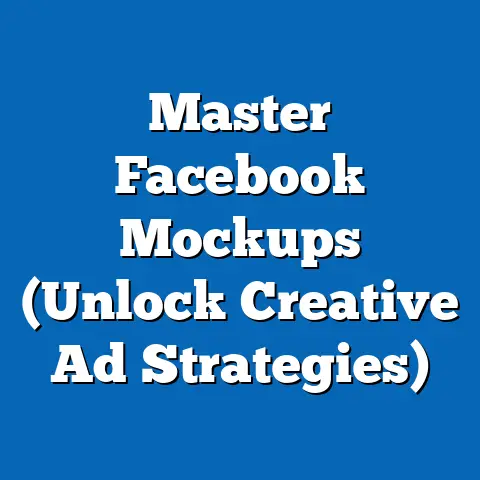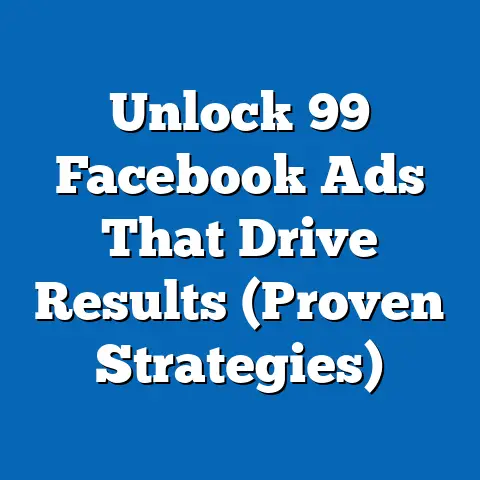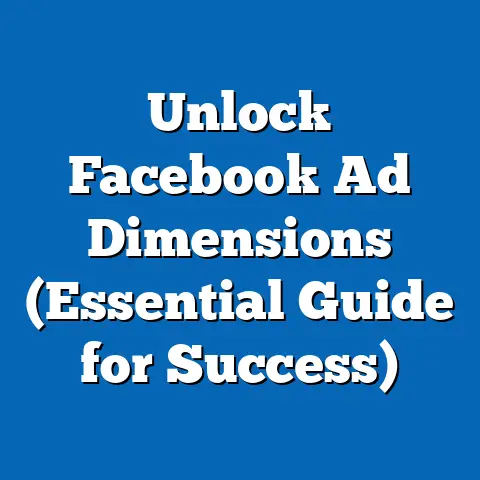Unlock Facebook Message Ads (Proven Strategies for Engagement)
Remember that scene in “The Social Network” where Mark Zuckerberg is frantically coding, trying to connect people in a new way? Or how about the iconic Central Perk chats in “Friends,” where relationships blossomed over simple conversations? These pop culture moments highlight a fundamental human need: connection through communication. Just like these stories, Facebook Message Ads offer a powerful way to connect with your audience on a personal level.
In today’s digital landscape, where attention spans are shorter than ever, breaking through the noise and forging genuine connections with potential customers is crucial. That’s where Facebook Message Ads come in. They aren’t just another ad format; they’re a direct line to your audience, offering a personalized and engaging experience that can drive significant results.
Section 1: Understanding Facebook Message Ads
Definition and Overview
So, what exactly are Facebook Message Ads? Simply put, they’re ads that appear in the Facebook Messenger app, allowing you to initiate conversations directly with potential customers. Unlike traditional ads that lead to a website or landing page, Message Ads open a direct line of communication, offering a more personalized and interactive experience.
Think of it as having a virtual storefront right within Messenger. When someone clicks on your ad, they’re not just passively viewing information; they’re actively engaging in a conversation with your brand. This direct interaction allows you to answer questions, provide personalized recommendations, and guide them through the customer journey.
Facebook offers two main types of Message Ads:
- Click-to-Messenger Ads: These ads appear in the Facebook News Feed, Instagram Feed, and other placements. When clicked, they open a conversation in Messenger.
- Sponsored Messages: These ads are sent directly to people who have already interacted with your Facebook Page in Messenger.
Benefits
Why should you consider using Facebook Message Ads? The benefits are numerous:
- Direct Communication: The most significant advantage is the ability to have one-on-one conversations with potential customers. This allows you to understand their needs, address their concerns, and build rapport.
- Personalized Experiences: Message Ads allow you to tailor your messaging based on individual user data and behavior. This personalization can significantly increase engagement and conversion rates.
- Increased Conversion Rates: By providing personalized support and answering questions directly, you can guide potential customers through the sales funnel more effectively, leading to higher conversion rates.
- Lead Generation: Message Ads are an excellent way to generate leads. You can collect contact information, qualify leads, and nurture them through personalized follow-up messages.
- Improved Customer Service: Message Ads can be used to provide instant customer support, resolving issues and answering questions in real-time. This can improve customer satisfaction and loyalty.
- Cost-Effective: In many cases, Message Ads can be more cost-effective than other ad formats, especially when you consider the potential for higher engagement and conversion rates.
I remember working with a client who ran a local fitness studio. They were struggling to generate leads through traditional Facebook ads. We decided to try Message Ads, offering a free consultation and trial session. The results were amazing! We saw a significant increase in leads and conversions, and the client was able to build stronger relationships with potential customers through personalized conversations.
Comparison
To truly appreciate the power of Message Ads, it’s helpful to compare them to other popular Facebook ad formats:
- Carousel Ads: Carousel Ads are great for showcasing multiple products or features. However, they lack the direct interaction offered by Message Ads.
- Video Ads: Video Ads can be highly engaging, but they’re a passive experience. Message Ads, on the other hand, encourage active participation.
- Lead Ads: Lead Ads are designed to collect contact information. However, they don’t offer the opportunity for personalized conversation and relationship building.
- Image Ads: Image Ads are simple and effective for driving traffic to a website. However, they lack the interactive element of Message Ads.
While each of these ad formats has its own strengths, Message Ads stand out for their ability to create personalized connections and drive meaningful engagement.
Takeaway: Facebook Message Ads offer a unique opportunity to connect with your audience on a personal level, driving engagement, conversions, and customer loyalty.
Next Steps: Consider how you can incorporate Message Ads into your existing Facebook advertising strategy. Think about the types of conversations you want to have with your audience and the goals you want to achieve.
Section 2: Crafting Compelling Messages
The key to success with Facebook Message Ads lies in crafting compelling messages that resonate with your target audience. It’s not enough to simply promote your product or service; you need to create a message that is engaging, informative, and personalized.
Personalization
In today’s world, generic marketing messages are often ignored. People want to feel like they’re being treated as individuals, not just another number in a database. That’s why personalization is so crucial.
According to a study by Epsilon, 80% of consumers are more likely to make a purchase from a brand that offers personalized experiences. This statistic highlights the importance of tailoring your messaging to resonate with each individual user.
Here are some ways to personalize your Facebook Message Ads:
- Use the user’s name: This is the most basic form of personalization, but it can still be effective.
- Reference past interactions: If a user has previously interacted with your Facebook Page or website, mention it in your message.
- Tailor your message based on demographics: Segment your audience based on age, gender, location, and other demographics, and create messages that are relevant to each segment.
- Use dynamic content: Facebook allows you to insert dynamic content into your messages, such as product recommendations based on past purchases or browsing history.
I once ran a campaign for an e-commerce client that sold personalized gifts. We segmented our audience based on their interests and created messages that highlighted relevant gift ideas. For example, if someone was interested in cooking, we would show them personalized cutting boards or aprons. This level of personalization resulted in a significant increase in click-through rates and conversions.
Tone and Voice
The tone and voice you use in your Message Ads can have a significant impact on how your message is received. It’s important to choose a tone and voice that is appropriate for your brand and your target audience.
Here are some factors to consider when determining your tone and voice:
- Your brand personality: Are you a fun and playful brand, or a serious and professional brand? Your tone and voice should reflect your brand personality.
- Your target audience: What kind of language does your target audience use? What are their values and interests?
- The context of the message: Is the message intended to be informative, persuasive, or entertaining?
For example, a brand that sells luxury watches might use a sophisticated and elegant tone, while a brand that sells skateboarding equipment might use a more casual and energetic tone.
One of my favorite examples of a brand that nails its tone and voice is Wendy’s. Their Twitter account is known for its witty and sarcastic responses, which resonates perfectly with their target audience. While this approach might not be suitable for every brand, it demonstrates the power of using a distinct and memorable tone.
Call-to-Action (CTA)
Your Call-to-Action (CTA) is the most important part of your Message Ad. It’s what tells users what you want them to do next. A strong CTA can significantly increase your click-through rates and conversions.
Here are some tips for crafting effective CTAs:
- Be clear and concise: Tell users exactly what you want them to do.
- Use strong action verbs: Use verbs like “Learn More,” “Shop Now,” “Get Started,” or “Download Now.”
- Create a sense of urgency: Use phrases like “Limited Time Offer” or “Shop Now Before It’s Too Late.”
- Make it visually appealing: Use a button or other visual element to make your CTA stand out.
- Test different CTAs: A/B test different CTAs to see which ones perform best.
Here are some examples of strong CTAs in real Facebook Message Ads:
- “Get a Free Quote” (for service-based businesses)
- “Shop the Sale” (for e-commerce businesses)
- “Learn More About Our Product” (for businesses with complex products)
- “Sign Up for Our Newsletter” (for businesses looking to build their email list)
Takeaway: Crafting compelling messages is essential for success with Facebook Message Ads. Personalize your messages, choose an appropriate tone and voice, and use strong CTAs to drive action.
Next Steps: Review your existing Message Ads and identify areas where you can improve your messaging. A/B test different copy, visuals, and CTAs to optimize your performance.
Section 3: Targeting the Right Audience
Even the most compelling message will fall flat if it’s not delivered to the right audience. Effective targeting is crucial for maximizing the ROI of your Facebook Message Ads.
Audience Segmentation
Audience segmentation involves dividing your target audience into smaller groups based on shared characteristics, such as demographics, interests, and behaviors. This allows you to create more relevant and personalized messages for each segment.
Here are some ways to segment your audience:
- Demographics: Age, gender, location, education, income, etc.
- Interests: Hobbies, passions, activities, etc.
- Behaviors: Past purchases, website visits, Facebook Page engagement, etc.
- Custom Audiences: Upload your own customer data (e.g., email addresses, phone numbers) to create custom audiences.
- Lookalike Audiences: Create lookalike audiences based on your existing customers or website visitors.
Facebook’s Audience Insights tool can be invaluable for understanding your target audience and identifying potential segments. This tool provides detailed information about the demographics, interests, and behaviors of people who like your Facebook Page or who are interested in your products or services.
I once worked with a clothing retailer that wanted to target young women with their Message Ads. We used Facebook’s Audience Insights tool to discover that their target audience was highly interested in fashion, beauty, and travel. We then created Message Ads that featured stylish clothing, beauty tips, and travel destinations, which resonated perfectly with this audience.
Lookalike Audiences
Lookalike Audiences are one of the most powerful targeting options available on Facebook. They allow you to reach potential customers who resemble your existing customers or website visitors.
Facebook uses its vast database of user information to identify people who share similar characteristics with your source audience. This can be a highly effective way to expand your reach and find new customers who are likely to be interested in your products or services.
Here are some tips for creating effective Lookalike Audiences:
- Use a high-quality source audience: The more accurate and representative your source audience is, the better your Lookalike Audience will be.
- Choose the right audience size: Facebook allows you to choose the size of your Lookalike Audience, ranging from 1% to 10% of the population in your target country. A smaller percentage will be more closely matched to your source audience, while a larger percentage will have a broader reach.
- Test different source audiences: Experiment with different source audiences to see which ones generate the best results.
Retargeting Strategies
Retargeting involves showing ads to people who have previously interacted with your website or Facebook Page. This is a highly effective way to re-engage potential customers who have shown interest in your products or services.
Here are some retargeting strategies you can use with Facebook Message Ads:
- Target website visitors: Show Message Ads to people who have visited specific pages on your website, such as product pages or checkout pages.
- Target Facebook Page engagers: Show Message Ads to people who have liked, commented on, or shared your Facebook posts.
- Target people who have abandoned their shopping cart: Send Message Ads to people who have added items to their shopping cart but didn’t complete the purchase.
Retargeting can significantly enhance engagement rates and improve ROI for your Message Ads. By showing relevant messages to people who have already expressed interest in your brand, you can increase the likelihood of conversion.
Takeaway: Targeting the right audience is crucial for maximizing the ROI of your Facebook Message Ads. Use audience segmentation, Lookalike Audiences, and retargeting strategies to reach the people who are most likely to be interested in your products or services.
Next Steps: Analyze your existing customer data and identify potential audience segments. Create Lookalike Audiences based on your best customers and website visitors. Implement retargeting strategies to re-engage potential customers who have shown interest in your brand.
Section 4: Timing and Frequency
The timing and frequency of your Message Ads can significantly impact their performance. Sending messages at the wrong time or too frequently can annoy potential customers and damage your brand reputation.
Optimal Timing
Determining the best times to send Message Ads for maximum visibility and engagement can be tricky, as it depends on your target audience and industry. However, there are some general guidelines you can follow:
- Consider your target audience’s schedule: When are they most likely to be online and checking their messages?
- Analyze your past campaign data: What times have generated the best results in the past?
- Use Facebook’s scheduling feature: Schedule your Message Ads to be sent at the optimal times.
According to a study by Sprout Social, the best times to post on Facebook are Wednesday at 11 a.m. and between 1 and 2 p.m. While this data is specific to organic posts, it can provide a general guideline for when people are most active on Facebook.
I recommend experimenting with different sending times to see what works best for your audience. A/B test different times and track your results to identify the optimal sending schedule.
Frequency Management
Sending too many Message Ads can be just as detrimental as sending them at the wrong time. Overwhelming potential customers with too many messages can lead to them ignoring your ads or even blocking your Facebook Page.
Here are some tips for managing the frequency of your Message Ads:
- Set frequency caps: Facebook allows you to set frequency caps, which limit the number of times a user will see your ads.
- Segment your audience: Send different messages to different segments of your audience to avoid repetition.
- Provide value with each message: Make sure each message is informative, engaging, or entertaining.
- Monitor your results: Track your engagement rates and adjust your frequency accordingly.
It’s a delicate balance between staying top-of-mind and annoying your audience. Err on the side of caution and prioritize quality over quantity.
Takeaway: Timing and frequency are crucial factors in the success of your Facebook Message Ads. Analyze your audience’s behavior, experiment with different sending times, and manage your frequency to avoid overwhelming potential customers.
Next Steps: Review your existing Message Ad schedule and identify potential areas for improvement. Implement frequency caps to limit the number of times a user sees your ads. Monitor your engagement rates and adjust your schedule accordingly.
Section 5: Utilizing Multimedia Elements
Incorporating multimedia elements into your Message Ads can significantly enhance their engagement and effectiveness. Visuals are processed much faster than text, and they can help capture attention and convey your message more effectively.
Images and Videos
Images and videos can make your Message Ads more visually appealing and engaging. They can also help you showcase your products or services in a more compelling way.
Here are some tips for selecting the right visuals:
- Use high-quality images and videos: Make sure your visuals are clear, sharp, and professional-looking.
- Choose visuals that are relevant to your message: Your visuals should directly support and enhance your message.
- Optimize your visuals for mobile: Most people will be viewing your Message Ads on their mobile devices, so make sure your visuals are optimized for smaller screens.
- Experiment with different formats: Try using images, videos, GIFs, and other visual formats to see what resonates best with your audience.
I’ve found that videos tend to perform particularly well in Message Ads. They allow you to tell a story, showcase your product in action, and connect with your audience on a more emotional level.
Interactive Features
Facebook offers a variety of interactive features that you can incorporate into your Message Ads to enhance user interaction. These features can make your ads more engaging and encourage users to take action.
Here are some examples of interactive features you can use:
- Quick Replies: Quick Replies are pre-defined responses that users can tap to quickly answer a question or provide information.
- Buttons: Buttons allow users to take specific actions, such as visiting your website, making a purchase, or contacting customer support.
- Carousels: Carousels allow you to showcase multiple products or features within a single Message Ad.
These interactive features can make your Message Ads more engaging and user-friendly, leading to higher click-through rates and conversions.
Case Studies
Let’s take a look at some examples of brands that have successfully used multimedia in their Message Ads:
- Sephora: Sephora uses Message Ads to offer personalized beauty advice and product recommendations. They incorporate images and videos to showcase their products and demonstrate how to use them.
- Domino’s: Domino’s uses Message Ads to allow customers to place orders directly through Messenger. They use Quick Replies to guide customers through the ordering process and make it easy to customize their orders.
- KLM: KLM uses Message Ads to provide customers with flight updates and travel information. They incorporate buttons that allow customers to check in for their flights, change their seats, or contact customer support.
These examples demonstrate the power of using multimedia and interactive features to create engaging and effective Message Ads.
Takeaway: Incorporating multimedia elements into your Message Ads can significantly enhance their engagement and effectiveness. Use high-quality images and videos, and take advantage of interactive features like Quick Replies, Buttons, and Carousels.
Next Steps: Review your existing Message Ads and identify opportunities to incorporate multimedia elements. Experiment with different visuals and interactive features to see what resonates best with your audience.
Section 6: Analyzing Performance Metrics
Measuring the performance of your Facebook Message Ads is crucial for understanding what’s working and what’s not. By tracking key metrics, you can identify areas for improvement and optimize your campaigns for maximum ROI.
Key Metrics
Here are some of the crucial metrics to track for assessing the performance of your Facebook Message Ads:
- Click-Through Rate (CTR): The percentage of people who clicked on your ad and started a conversation in Messenger.
- Engagement Rate: The percentage of people who interacted with your message (e.g., by tapping a Quick Reply or clicking a Button).
- Conversion Rate: The percentage of people who completed a desired action (e.g., making a purchase, signing up for a newsletter).
- Cost Per Click (CPC): The average cost you paid for each click on your ad.
- Cost Per Conversion (CPC): The average cost you paid for each conversion.
- Return on Ad Spend (ROAS): The revenue you generated for every dollar you spent on advertising.
By tracking these metrics, you can gain valuable insights into the performance of your Message Ads and identify areas where you can improve.
A/B Testing
A/B testing involves testing different versions of your Message Ads to see which one performs best. This can be a highly effective way to optimize your campaigns and improve your results.
Here are some elements you can A/B test:
- Copy: Test different headlines, body text, and CTAs.
- Visuals: Test different images, videos, and GIFs.
- Targeting: Test different audience segments and targeting options.
- Sending Times: Test different sending times to see what works best for your audience.
I recommend using Facebook’s A/B testing feature to easily create and track different versions of your Message Ads. This feature allows you to see which version is performing best and automatically allocate more budget to the winning version.
Adjusting Strategies
Analyzing data and adjusting strategies based on performance results is an ongoing process. It’s not enough to simply set up your Message Ads and let them run; you need to continuously monitor their performance and make adjustments as needed.
Here are some tips for adjusting your strategies:
- Analyze your data regularly: Set aside time each week to review your performance metrics and identify trends.
- Identify areas for improvement: What’s working well, and what’s not?
- Experiment with new strategies: Don’t be afraid to try new things and see what works best.
- Stay up-to-date with Facebook’s latest features and best practices: Facebook is constantly evolving, so it’s important to stay informed about the latest changes.
By continuously analyzing your data and adjusting your strategies, you can ensure that your Facebook Message Ads are performing at their best.
Takeaway: Analyzing performance metrics is crucial for understanding what’s working and what’s not. Track key metrics, A/B test different elements, and adjust your strategies based on performance results.
Next Steps: Set up tracking for your Message Ads and begin monitoring your performance metrics. A/B test different copy, visuals, and targeting options to optimize your campaigns.
Remember, effective communication is at the heart of successful Facebook Message Ads. Just like the characters in “The Social Network” and “Friends,” you need to connect with your audience on a personal level, understand their needs, and provide them with valuable information and support.
I encourage you to implement the strategies discussed in this guide and share your experiences and successes with Facebook Message Ads. By embracing this powerful ad format and continuously optimizing your campaigns, you can drive significant engagement, conversions, and customer loyalty.
Now, go out there and create some amazing Facebook Message Ads that connect with your audience and drive results!





